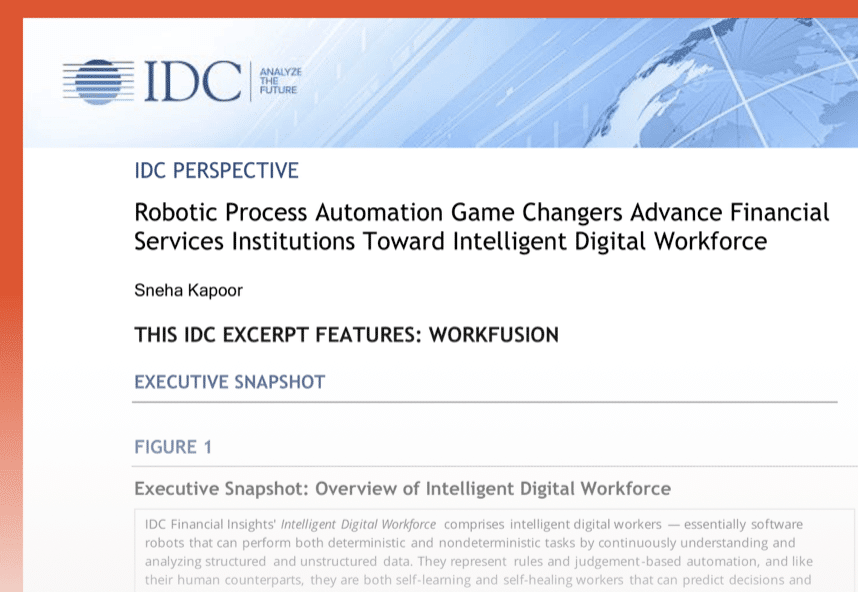Artificial intelligence and cognitive computing opened a new era in automatization. Only three years ago, the prospect of business process automation by means of RPA innovation was often met with the question, “Will it work?” Now that nearly every enterprise has deployed some form of robotic process automation (RPA) technology, its feasibility and value have been proven. The critical question has become, “Will it scale?” The full potential of artificial intelligence/cognitive computing applications in robotics is yet to be explored.
According to IDC analyst Sneha Kapoor’s latest research report, “Robotic Process Automation Game Changers Advance Financial Services Institutions Toward Intelligent Digital Workforce,” many financial institutions that embraced RPA technology have not been able to scale their automation deployments. Along with highlighting the problem of scalability, the report clearly differentiates a “digital workforce” from an “intelligent digital workforce.”
Building on research of financial institutions across APAC, this excellent report will help any enterprise across the globe better understand the intelligent automation market and learn what to look for in a technology partner to help drive scalable operations transformation towards an intelligent digital workforce. We’re also proud WorkFusion was highlighted as a strong example of artificial intelligence or cognitive computing solutions/services.
What makes automation intelligent
The term “intelligent automation” is starting to pop up more frequently, even from software companies that have historically billed themselves as just RPA providers. But is their automation actually intelligent? IDC offers the following definition of intelligent automation: “software robots that can perform both deterministic and non-deterministic tasks by continuously understanding and analyzing structured and unstructured data.” Note these three critical terms:
- Non-deterministic — The task isn’t precisely repetitive and requires judgment, and the intelligent software robot must be able to vary outputs according to variable inputs.
- Continuously understanding — The intelligent software robot must ingest new, variable data and continuously adapt while maintaining a consistently accurate output.
- Unstructured data — Refers to 90% of the big data a typical business handles, and most are from documents (particularly within banks).
IDC says these intelligent software robots, “like their human counterparts, are both self-learning and self-healing workers that can discover patterns to predict decisions and even offer recommendations to improve them.” Whereas first-generation RPA products used rules to follow repetitive patterns, such as opening an application and logging in, intelligent automation has progressed towards machine learning or, as stated in the report — towards “augmenting human intelligence, as well as evolving quickly to achieve the potential of autonomously emulating this intelligence.”
And the key capability that makes automation intelligent? Artificial intelligence.
Defining “cognitive/artificial intelligence”
What does cognitive computing and artificial intelligence mean? “Cognitive” and “AI” (or another synonym —predictive analytics) are favorite buzzwords for enterprise software marketing departments. The terms are used so often, by such a wide array of products, that it’s difficult to know what each vendor means and whether or not the products are actually built with intelligence. IDC helps end the ambiguity with a short, clear definition: “IDC defines cognitive/artificial intelligence as systems that learn, reason, and self-correct.” If an RPA bot does not have this capability natively, it isn’t intelligent. Within native AI, rules-based or deterministic bots require frequent retraining — which precludes users of first-generation RPA products from scaling their automation programs to perform complex functions autonomously, enterprise-wide.
Spotlighting WorkFusion platform’s capability, simplicity, scalability and analytics
After spending time with WorkFusion’s intelligent automation platform, the report authors remark:
“Even its AI model can scale up with no need for additional programming and can run on standard hardware to make automation portable across functions, business units, and geographies. Much of this simplicity is due to WorkFusion’s AutoML, a capability that analyzes process data using input and output data from completed tasks to pick algorithms, train models, and insert models into the automation in a seamless, nondisruptive fashion.”
Recognizing the importance of measurement and reporting to all large enterprises, IDC analysts noted that WorkFusion’s “predictive analytics provide full visibility and centralized view of automation across bots and processes so that users can better plan cost and capacity.”
Also published on Medium.





























